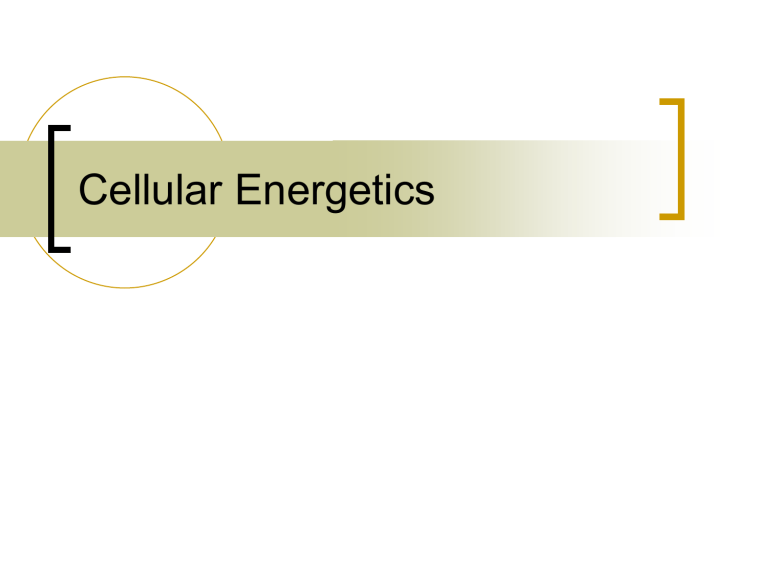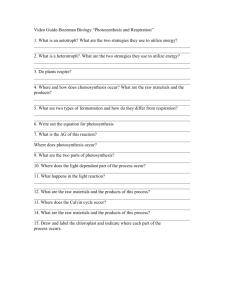Cellular Energetics powerpoint

Cellular Energetics
Catabolic pathways
Fermentation: Partial degradation (O
2
)
Cellular respiration: Full degradation (O
2
)
Organic compounds + O
2 energy (gasoline burning)
CO
2
+ H
2
O +
C
6
H
12
O
6
+ 6O
2
6CO
2
+ 6H
2
O + energy
Redox reactions
Explains how energy is yielded by transfer of electrons
Oxidation: Loss of electrons
Reduction: Gain of electrons (OILRIG)
Na + Cl Na+ + Cl- (complete transfer)
To pull electrons away from an atom requires input of energy
Partial transfer
More electronegative more energy needed
When electrons shift from less electronegative to more electronegative atom Electron loses potential energy, which is released as heat
C
6
H
12
O
6
C
6
H
12
O
6
+ 6O
2
6CO
2
+ 6H
2
O + energy is oxidized/reduced while O
2 is oxidized/reduced
C
6
H
12
O
6 is the _____agent while O
2 is the ____ agent.
This reaction is considered exergonic/endergonic , therefore it is spontaneous/not spontaneous and has a
+/change in free energy
Why are many organic molecules great fuels?
When a spark is applied to gasoline and oxygen it burns and releases a LARGE quantity of energy. Why doesn’t glucose do the same thing in the presence of O body?
2 in your
Enzyme facilitate the break down of organic fuels to CO
2 in a SERIES of steps. Why not just one step?
Electrons (along with a proton) are stripped from glucose, but not directly to O
2
, instead they are transferred to…
NAD
Conezyme derived from the vitamin niacin
NAD ox vs NAD re
Very little PE lost
Energy can be tapped into when ATP needs to be made
How do electrons finally reach oxygen?
Substrate level phosphorylation
Enzymes transfer a phosphate group from the substrate to
ADP
In oxidative phosphorylation
(discussed tomorrow) inorganic phosphate is added to ADP
Glycolysis “splitting of sugar”
Location?
Inputs?
Outputs?
Purpose?
Fermentation
Lab 5: Cellular Respiration
Lab 5: Cellular Respiration
Description
using respirometer to measure rate of O
2 production by pea seeds
non-germinating peas
germinating peas
effect of temperature
control for changes in pressure & temperature in room
Lab 5: Cellular Respiration
Concepts
respiration
experimental design
control vs. experimental
function of KOH
function of vial with only glass beads
Lab 5: Cellular Respiration
Conclusions
temp =
respiration
germination =
respiration calculate rate?
Sources of energy
Photosynthesis
(photoautotroph)
Autotrophs (self-feed from CO2 and inorganic materials): plants, some algae, some bacteria
Synonym: Producers
Chemosynthesis (chemoautotroph)
Chloroplast structure
Read through :birth of complex cells to get further detail about other plastids and organelles such as peroxisomes
Water: roots veins mesophyll cells
Sugar: mesophyll cells veins rest of plant
CO2, O2 stomata
Absorbing/reflecting light
Problem: How do plants utilize energy from light to produce carbohydrates?
Properties of light
While traveling, acts as a wave (properties depend on this wavelength)
When interacting with matter
(like your clothes) acts as a particle
Photon: Discrete packet of light
Pigment structure/function
Pigment structure/function
When chlorophyll absorbs light, energy is transferred to electrons.
Plant pigments
Chlorophyll a : primary pigment
Chlorophyll b : broadens range of wavelengths that can be used
Carotenoids : Also broadens range, absorbs, dissipates excessive energy, prevents interaction w/ O2
EAT YOUR CARROTS, why?
Light dependent reactions
Role of chlorophyll:
Capture energy from light
Role of an electron carrier: transport electrons which carry the energy initially from light
(NADP+ + 2e- + H+
NADPH)
6CO
2
+ 6H
2
O light
>
C
6
H
12
O
6
+ 6O
2
Where does the O2 come from?
Hypothesis 1: CO2 + C C + O2
C + H2O CH2O
Hypothesis 2 (van Niels)
Studies bacteria that DIDN’t produce O2
CO2 + 2H2S CH2O + H2O + 2S
CO2 + 2H 2O CH2O + H2O + O2
Visible globules
Confirmed with radioactive tracers to track its fate
REDOX chemistry
REDOX! Water is split electrons and Hydrogen ions to CO2. Electrons increase in potential energy, so energy is NEEDED! (endergonic, + ΔG)
CO2 is reduced to sugar
H2O is oxidized
Photosynthesis overview
NAD P + : Same function as NAD+
Photophosphorylation
How do photosystems work?
Only photons with energy equal to the atoms ground state excited stated is absorbed
Redox Why does isolated chlorophyll fluoresce?
Noncylic electron flow
Noncylic electron flow
Noncylic electron flow
Noncylic electron flow
Noncylic electron flow
Noncylic electron flow
Cyclin electron flow
Function: Regenerate ATP lost through Calvin Cycle (more
ATP consumed than NADPH)
Electron transport chain
Location: _____
Input: ______
Output: ___
Purpose: _____
Chemiosmosis comparison
Calvin Cycle
Purpose: _____
Location: ____
Input : ____
Output : ____
Lab 4: Photosynthesis
Lab 4: Photosynthesis
Description
determine rate of photosynthesis under different conditions
light vs. dark
boiled vs. unboiled chloroplasts
chloroplasts vs. no chloroplasts
use DPIP in place of NADP +
DPIP ox
= blue
DPIP red
= clear
measure light transmittance
paper chromatography to separate plant pigments
Lab 4: Photosynthesis
Concepts
photosynthesis
Photosystem 1
NADPH
chlorophylls & other plant pigments
chlorophyll a
chlorophyll b
xanthophylls
carotenoids
experimental design
control vs. experimental
Lab 4: Photosynthesis
Conclusions
Pigments
pigments move at different rates based on solubility in solvent
Photosynthesis
light & unboiled chloroplasts produced highest rate of photosynthesis
Which is the control?
#2 (DPIP + chloroplasts + light)







